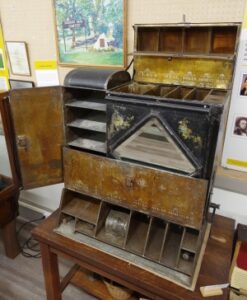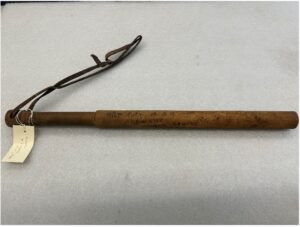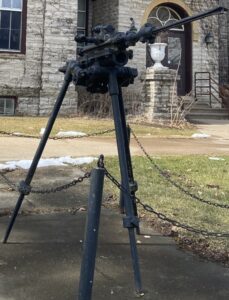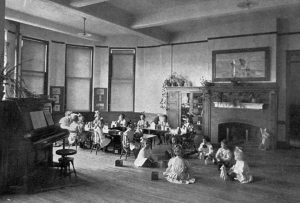Educators across the state use Wisconsin 101 in undergraduate classrooms to help their students think about material culture and public history. One way to engage with Wisconsin 101 is to have your students write clusters like the ones you see on our site.
This page outlines a tested course assignment, provides examples from our website of writing produced by students who have completed this assignment, and offers some sample syllabi and useful readings to help you implement a Wisconsin 101 project in your own classroom.
Writing a History "Cluster" for Wisconsin 101
This is a multi-stage assignment that culminates in producing an essay “cluster”, one object history and two related stories, in the style of Wisconsin 101. If you or your students choose, a final step of this assignment could be submitting these stories for publication on WI 101. For each of these steps, you’ll find materials for students and grading rubrics. The steps of this assignment are as follows:
1. Choosing an Object
The first step of this process is choosing an object on which to write an object history. It’s difficult to over-emphasize how important object selection is, as a well-chosen object will provide a solid foundation for the essay cluster and ground the stories in a specific location in Wisconsin. Ideally, students will be able to engage with their object in person, as this allows them to get a feel for it’s size, shape, and materiality. This also offers the potential for collaborating with local museums, libraries and archives to research objects in their collections.
Students might be tempted to focus on a historical event or person and work backwards to an object, but the most successful clusters are centered on the object itself. Allowing students to interact with the physical objects helps generate their own research questions based on their observations.
We also suggest, especially for those wishing to submit their work to our website, that they choose an object that has a strong connection to a specific location. This may be where the object was made, or it may be symbolic or emblematic of that place, or it may be associated with an individual who lived there. It has been our experience that objects without a clear connection to a place tend to balloon very quickly, and some guidance can slow student projects from becoming overwhelming.
2. Writing an Object History
Based on their observations of the object and the research questions that process has generated, students will begin by writing a 400-500 word object history.
3. Research Plan
After completing their object histories, students will develop questions for further research and find sources to help answer these questions. These questions and sources will guide students in the process of writing their related stories.
4. Related Stories
Once they’ve completed more research into their objects and questions, students will write two (2) 600-750 word stories related to their object each citing at least three (3) sources. These stories should fill out the readers’ understanding of the object, expand on the object’s connection to a location, and place the object in historical context.
5. Final Polished Cluster
Now that students have written all of the elements of a cluster, they should take some time to polish them making sure they each make a historical claim and clearly connect to each other.
Optional - 6. Submission for Publication
Once students have finished their cluster of three stories, they could submit them to Wisconsin 101 for possible publication. It’s important to make sure students have a sense of the publishing process before they submit. As with most publications, submission is no guarantee that the cluster will be published. The vast majority of submissions to Wisconsin 101 require the author to work with our editor to bring the cluster to the point where it’s publishable, and some submissions never reach that point or are unsuitable for publication. This editorial process can take a fair bit of time and labor even after students have completed a polished cluster for your course. If students do plan to submit to Wisconsin 101, they should ensure that their cluster doesn’t duplicate any material on the site.
Developed by Dr. Patricia Stovey for the course History 321: Wisconsin History at UW – La Crosse.
“This assignment is divided into a number of parts with due dates and point totals that are spread across the semester. Therefore, you will be expected to research, write, and revise all semester long. Welcome to the real world of a scholar!”
Sample Syllabi
Below you will find some example syllabi which highlight how Wisconsin 101 can support your learning goals:
Instructor: Dr. Krista Grensavitch, UW – Milwaukee.
“This course is designed as an introduction to the interdisciplinary field of Material Culture Studies; situated within the discipline of History, the course will also draw from scholarship from Anthropology, Archaeology, Women’s and Gender Studies, and Art History. The primary goal of this course is to familiarize students with key issues, questions, and debates within practices of writing object-based histories as well as within Material Culture Studies.”
Instructor: Dr. John Hall, UW – Madison.
“Unlike other sections of ‘The Historians Craft (HIST 201),’ which typically culminate in a proposal for future research, this course will require you to identify, analyze, and research an artifact of Wisconsin history and present your findings in three media: a ten-page research paper, a twelve-minute oral presentation, and approximately 2,000 words of web content regarding the artifact.”
Instructor: Dr. Patricia Stovey, UW – La Crosse.
“This course is an exploration of the history of Wisconsin, focusing on place, people, and the development of regional culture. Special emphasis will be given to environment, native peoples, ethnicity, state politics, and community from the territorial period to the recent past.”
Instructor: Dr. Leslie Belais, UW – Madison
“This course will introduce students to the practice of public history. Public historians ground their work in rigorous, academic research with the goal of presenting history in a collaborative and publicly focused manner. Students will learn how academic history gets translated to the public, not only by reading about public history, but by doing it.”
Suggested Course Readings & Resources
Note: The Wisconsin Historical Society, the Wisconsin Historical Society Press, and the Wisconsin Magazine of History are the essential starting points for locating secondary source, undergraduate-level appropriate research on the history of Wisconsin. Additional helpful University Presses that sometimes publish works in Wisconsin history include, of course, the University of Wisconsin Press, as well as the many university presses of the Midwestern region. Several university databases, including America: History and Life, can also be exceptional starting points for finding secondary research on your topic. And students should also keep in mind the many academic journals that often publish in areas of Wisconsin history, including the Middle West Review, the Journal of American History, the Mississippi Valley Historical Review, and more. Students may also want to consult the Wisconsin Blue Book, a biennial publication of the state’s Legislative Reference Bureau, which also contains several essays and invaluable economic, political, and demographic information. (Author: Jesse Gant)
Ivan Gaskell and Sarah Anne Carter, eds. The Oxford Handbook of History and Material Culture. New York & Oxford: Oxford University Press, 2020.
Laurel Thatcher Ulrich, Ivan Gaskell, Sara Schechner, and Sarah Anne Carter, Tangible Things: Making History Through Objects. Oxford & New York: Oxford University Press, 2015.
Jane Bennett. Vibrant Matter, A Political Ecology of Things. Durham: Duke University Press, 2010.
Fiona Candlin and Raiford Guins, eds. The Object Reader. New York: Routledge, 2009.
Dawes, Rufus R. Service with the Sixth Wisconsin Volunteers. Marietta, Ohio: E.R. Alderman & Sons, 1890.
Larson, Olaf F. When Horses Pulled the Plow: Life of a Wisconsin Farm Boy 1910-1929. Madison: The University of Wisconsin Press, 2011.
Leopold, Aldo. A Sand County Almanac, And Sketches Here and There. New York: Oxford University Press, 2020.
Zimm, John, ed. This Wicked Rebellion: Wisconsin Civil War Soldiers Write Home. Foreword by Michael Edmonds. Madison, WI: Wisconsin Historical Society Press, 2012.
Janik, Erika. A Short History of Wisconsin. Madison: Wisconsin Historical Society Press, 2010.
Smith, Alice E., et al. The History of Wisconsin. 6 Vols. Madison: Wisconsin Historical Society Press, 1973-1990.
Brown, David S. Beyond the Frontier: The Midwestern Voice in American Historical Writing. London: University of Chicago Press, 2009.
Goldstein, Amy. Janesville: American Story. New York: Simon & Schuster, 2017.
Hall, John W. Uncommon Defense: Indian Allies in the Black Hawk War. Cambridge: Harvard University Press, 2010.
Kantrowitz, Stephen. Citizens of a Stolen Land: A Ho-Chunk History of the Nineteenth-Century United States. Chapel Hill: The University of North Carolina Press, 2023.
Kaufman, Dan. The Fall of Wisconsin: The Conservative Conquest of a Progressive Bastion and the Future of American Politics. New York. W.W. Norton & Company, 2019.
Loew, Patty. Indian Nations of Wisconsin: Histories of Endurance and Renewal. Madison, WI: Wisconsin Historical Society Press, 2013.
McManus, Michael J. Political Abolitionism in Wisconsin, 1840-1861. Kent, Ohio: Kent State University Press, 1998.
Nesper, Larry. The Walleye War: The Struggle for Ojibwa Spearfishing and Treaty Rights. Lincoln: University of Nebraska Press, 2002.
Saler, Bethel. The Settlers’ Empire: Colonialism and State Formation in America’s Old Northwest. Philadelphia: University of Pennsylvania Press, 2014.
Trotter, Joe William. Black Milwaukee: The Making of an Industrial Proletariat, 1915-45. Urbana: University of Illinois Press, 2007.
Wagner, R. Richard. We’ve Been Here All Along: Wisconsin’s Early Gay History. Madison, Wisconsin: Wisconsin Historical Society Press, 2019.
Wyman, Mark. The Wisconsin Frontier. Bloomington: Indiana University Press, 2011.
Cayton, Andrew, Richard Sisson, Christian Zacher, eds. The American Midwest: An Interpretive Encyclopedia. Bloomington: Indiana University Press, 2007.
Dotts, Barbara ed. Wisconsin History: An Annotated Bibliography. Westport, Conn: Greenwood Press, 1999.
Holter, Darryl. Workers and Unions in Wisconsin: A Labor History Anthology. Madison: State Historical Society of Wisconsin, 1999.
Meine, Curt and Keef Keeley, eds. The Driftless Reader. Madison: University of Wisconsin Press, 2017.
McBride, Genevieve G. Women’s Wisconsin: From Native Matriarchies to the New Millennium. Madison, WI: Wisconsin Historical Society Press, 2005.
Ostergren, Robert C. and Thomas R. Vale, eds. Wisconsin Land and Life. Madison: The University of Wisconsin Press, 1997.
Wisconsin Cartographers’ Guild. Wisconsin’s Past and Present: A Historical Atlas. Madison: The University of Wisconsin Press, 1998.



